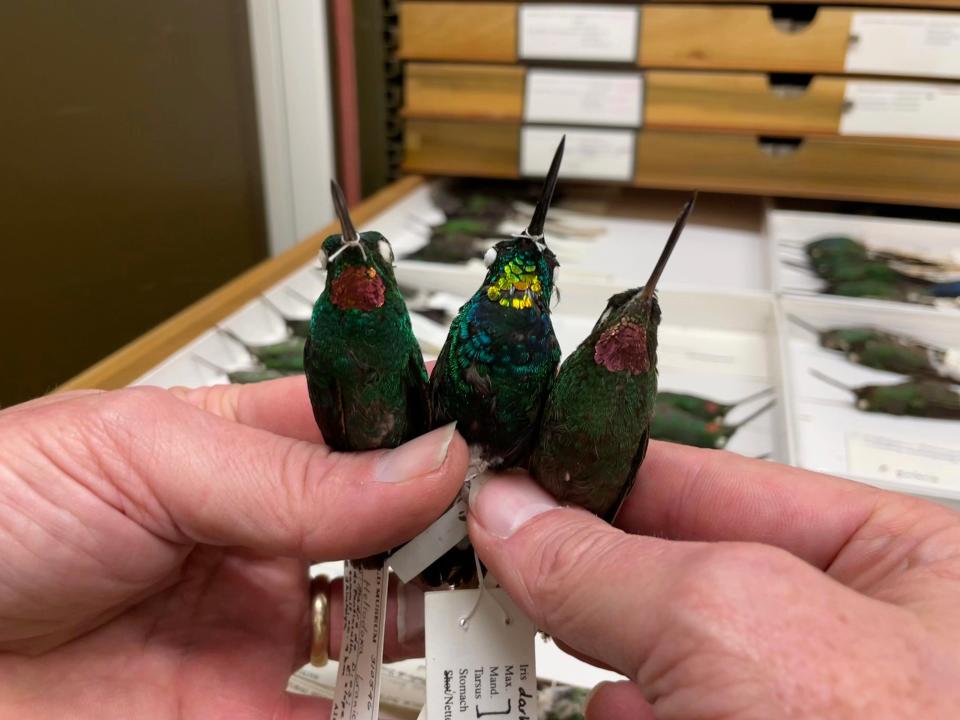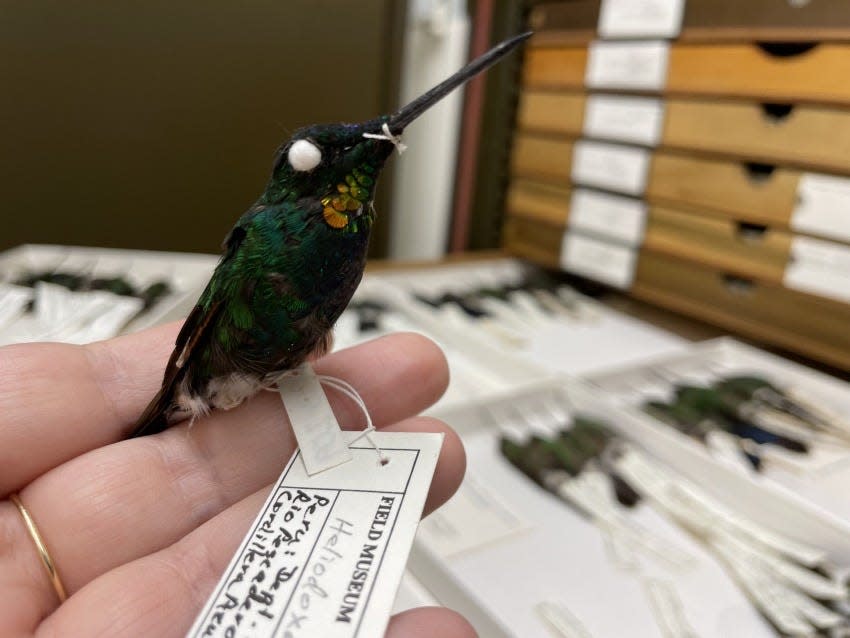New 'hybrid' hummingbird with unusual glittering gold feathers puzzles scientists
When researchers found a hummingbird with glittering gold feathers, they initially thought a new species had been discovered, but what they actually found was far more unusual.
The bird — found in Cordillera Azul National Park in the Peruvian Andes — is a never-before-documented hybrid of two different species that are native to western South America: the Pink-throated Brilliant hummingbird, Heliodoxa gularis, and the Rufous-webbed Brilliant hummingbird, Heliodoxa branickii. Published earlier this year in the journal Royal Society Open Science, researchers say the discovery opens the door to more questions about hybridization.
Separate hummingbird species are genetically distinct and typically don’t interbreed with each other, according to a press release about the study from Chicago’s Field Museum, but “hybrids break that rule.” How common hummingbird hybrids are is unknown to researchers, but they might be a driver behind color change.
“It’s not clear how common hummingbird hybrids like the one in this study are, but the researchers speculate that hybrids like this one might contribute to the diversity of structural colors found across the hummingbird family tree.”

More: Bird feeding can be great for humans but could harm the birds we love, study shows
Both the Pink-throated Brilliant hummingbird and the Rufous-webbed Brilliant hummingbird have bright pink throats, so researchers wanted to understand how the two combined would produce a gold-throated hummingbird.
According to the press release, it’s rare in the hummingbird family for members of the same species to have dramatically different throat colors, which is why scientists were puzzled when the birds' DNA matched.
“Sometimes hybrids are weird one-offs or are sterile, like mules; in other cases, hybrids can form new species,” the statement reads.
Using the speed of color evolution seen in hummingbirds, researchers estimated it would take 6-10 million years for this drastic pink-gold color shift to evolve in a single species.
“I looked at the bird and said to myself, ‘This thing doesn’t look like anything else.’ My first thought was, it was a new species,” said John Bates, the senior author of the study and curator of birds at Field Museum.
So, how did this unusual bird come to be? The answer has to do with the "complex ways in which iridescent feather colors are determined," according to the Field Museum.

Swarms of birds will fly over the US: Explore BirdCast's new fall migration tool to help you prepare.
How do hummingbirds get their coloring? ‘It’s like cooking.’
According to the Field Museum, feathers get their base color from pigment, like melanin (black) and carotidnoids (red and yellow), but a hummingbirds’ are iridescent, meaning their color depends on how light is bent and filtered as it hits the feather cells at different angles. Color-shifting iridescence is a result of structural color, which is when light interacts with the micro- or nano-structures on a creature.
“It’s a little like cooking: if you mix salt and water, you kind of know what you're gonna get, but mixing two complex recipes together might give more unpredictable results,” said Field Museum senior research scientist Chad Eliason.
“This hybrid is a mix of two complex recipes for a feather from its two parent species.”
10 facts about hummingbirds
Hundreds of species: There are currently 363 recognized species, but that number continues to grow as new species are identified, according to the Hattiesburg American, part of USA TODAY Network.
Only in the Americas: Hummingbirds are found nowhere else in the world except in the Americas. However, that may not have always been the case. 30 million years ago a hummingbird ancestor lived in the area now known as Poland and Germany.
Smallest birds in the world: Hummingbirds as a family are the smallest birds on Earth, but they aren't all the same size. The bee hummingbird is the smallest bird in the world weighing 2 grams. For comparison, a penny weighs 2.5 grams.
Frigid sleepers: The body temperatures of hummingbirds is around 104 degrees, but that can plunge at night. They go into a hibernation-like state when sleeping and their body temperatures have been recorded as low as 38 degrees.
Spiders help build nests: Hummingbirds build nests using lichens and line it with very soft plant material, but they depend on spiders to provide some of the construction material. The birds use silk from spider webs to bind the other materials together.
Nests that grow: Because of what hummingbirds use to build their nests, they are flexible and expand as the baby birds grow to accommodate the increase in size.
Tiny eggs: Hummingbirds typically lay two eggs and they are roughly the size of a Tic Tac.
Long-distance travelers: Hummingbirds can travel thousands of miles while migrating. Ruby-throated hummingbirds have the longest over-water flight of hummingbirds and travel 500-600 miles non-stop over the Gulf of Mexico.
Incredible eaters: Hummingbirds have big appetites and consume twice their weight in food daily. To put that in perspective, that's the same as a 150-pound person eating 1,200 1/4-pound hamburger patties every day.
Spiders help feed humming birds, too: In addition to nectar, the birds eat small flying insects and some of those they pick from spider webs.
Contributing: Brian Broom
This article originally appeared on USA TODAY: New hummingbird with unusual glittering gold feathers shocks experts

